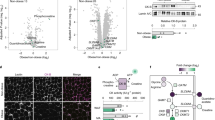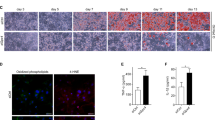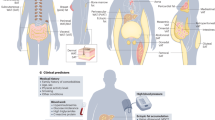Abstract
Background/Objectives:
To gain further insight into the role of adipocyte mitochondria in systemic lipid metabolism, inflammation and insulin sensitivity in humans and to provide a better understanding of the mechanisms of action of the peroxisome proliferator-activated receptor gamma agonist pioglitazone.
Subjects/Methods:
Mitochondrial DNA (mtDNA) copy number, mitochondrial distribution, mitochondrial and overall cellular protein abundances as well as intrinsic mitochondrial function of subcutaneous adipocytes were assessed by real-time quantitative PCR, MitoTracker staining, global proteomics analyses and NADH cytochrome c reductase activity in insulin-sensitive, normal-glucose-tolerant (NGT) individuals and age, gender, adiposity-matched insulin-resistant individuals with abnormal glucose tolerant (AGT) before and after 3 months of pioglitazone treatment.
Results:
mtDNA copy number/adipocyte and mtDNA copy number/adipocyte volume were ~55% and ~4-fold lower in AGT than in NGT, respectively, and correlated positively with the M-value of euglycemic clamps and high-density lipoprotein, and negatively with fasting plasma triglyceride, tumor necrosis factor-α and interleukin-6 levels in the entire cohort. mtDNA copy number/adipocyte volume also correlated positively with plasma adiponectin. Pioglitazone, which improved insulin sensitivity, plasma lipids and inflammation, increased the mitochondrial copy number, and led to a redistribution of mitochondria from a punctate to a more reticular pattern as observed in NGT. This was accompanied by disproportionately increased abundances of mitochondrial proteins, including those involved in fat oxidation and triglyceride synthesis. Pioglitazone also increased the abundance of collagen VI and decreased the abundance of cytoskeletal proteins. NADH cytochrome c reductase activity of isolated adipocyte mitochondria was similar in AGT and NGT and unaltered by pioglitazone.
Conclusions:
Adipocyte mitochondria are deficient in insulin-resistant individuals and correlate with systemic lipid metabolism, inflammation and insulin sensitivity. Pioglitazone induces mitochondrial biogenesis and reorganization as well as the synthesis of mitochondrial proteins including those critical for lipid metabolism. It also alters extracellular matrix and cytoskeletal proteins. The intrinsic function of adipocyte mitochondria appears unaffected in insulin resistance and by pioglitazone.
This is a preview of subscription content, access via your institution
Access options
Subscribe to this journal
Receive 12 print issues and online access
$259.00 per year
only $21.58 per issue
Buy this article
- Purchase on Springer Link
- Instant access to full article PDF
Prices may be subject to local taxes which are calculated during checkout



Similar content being viewed by others
References
Kusminski CM, Scherer PE . Mitochondrial dysfunction in white adipose tissue. Trends Endocrinol Metab 2012; 23: 435–443.
Mracek T, Drahota Z, Houstek J . The function and the role of the mitochondrial glycerol-3-phosphate dehydrogenase in mammalian tissues. Biochim Biophys Acta 2013; 1827: 401–410.
Haring HU, Rinninger F, Kemmler W . Decreased insulin sensitivity due to a postreceptor defect as a consequence of ATP-deficiency in fat cells. FEBS Lett 1981; 132: 235–238.
Steinfelder HJ, Joost HG . Reversible reduction of insulin receptor affinity by ATP depletion in rat adipocytes. Biochem J 1983; 214: 203–207.
Koh EH, Park JY, Park HS, Jeon MJ, Ryu JW, Kim M et al. Essential role of mitochondrial function in adiponectin synthesis in adipocytes. Diabetes 2007; 56: 2973–2981.
Wilson-Fritch L, Nicoloro S, Chouinard M, Lazar MA, Chui PC, Leszyk J et al. Mitochondrial remodeling in adipose tissue associated with obesity and treatment with rosiglitazone. J Clin Invest 2004; 114: 1281–1289.
Rong JX, Qiu Y, Hansen MK, Zhu L, Zhang V, Xie M et al. Adipose mitochondrial biogenesis is suppressed in db/db and high-fat diet-fed mice and improved by rosiglitazone. Diabetes 2007; 56: 1751–1760.
Choo HJ, Kim JH, Kwon OB, Lee CS, Mun JY, Han SS et al. Mitochondria are impaired in the adipocytes of type 2 diabetic mice. Diabetologia 2006; 49: 784–791.
Bostrom P, Wu J, Jedrychowski MP, Korde A, Ye L, Lo JC et al. A PGC1-alpha-dependent myokine that drives brown-fat-like development of white fat and thermogenesis. Nature 2012; 481: 463–468.
Roberts LD, Bostrom P, O'Sullivan JF, Schinzel RT, Lewis GD, Dejam A et al. Beta-aminoisobutyric acid induces browning of white fat and hepatic beta-oxidation and is inversely correlated with cardiometabolic risk factors. Cell Metab 2014; 19: 96–108.
Rao RR, Long JZ, White JP, Svensson KJ, Lou J, Lokurkar I et al. Meteorin-like is a hormone that regulates immune-adipose interactions to increase beige fat thermogenesis. Cell 2014; 157: 1279–1291.
Kaaman M, Sparks LM, van Harmelen V, Smith SR, Sjolin E, Dahlman I et al. Strong association between mitochondrial DNA copy number and lipogenesis in human white adipose tissue. Diabetologia 2007; 50: 2526–2533.
Bogacka I, Xie H, Bray GA, Smith SR . Pioglitazone induces mitochondrial biogenesis in human subcutaneous adipose tissue in vivo. Diabetes 2005; 54: 1392–1399.
Xie X, Yi Z, Sinha S, Madan M, Bowen BP, Langlais P et al. Proteomics analyses of subcutaneous adipocytes reveal novel abnormalities in human insulin resistance. Obesity 2016; 24: 1506–1514.
Ahmed M, Neville MJ, Edelmann MJ, Kessler BM, Karpe F . Proteomic analysis of human adipose tissue after rosiglitazone treatment shows coordinated changes to promote glucose uptake. Obesity 2009; 18: 27–34.
Rabilloud T, Kieffer S, Procaccio V, Louwagie M, Courchesne PL, Patterson SD et al. Two-dimensional electrophoresis of human placental mitochondria and protein identification by mass spectrometry: toward a human mitochondrial proteome. Electrophoresis 1998; 19: 1006–1014.
Jafari M, Primo V, Smejkal GB, Moskovets EV, Kuo WP, Ivanov AR . Comparison of in-gel protein separation techniques commonly used for fractionation in mass spectrometry-based proteomic profiling. Electrophoresis 2012; 33: 2516–2526.
American Diabetes Association. Classification and Diagnosis of Diabetes. Diabetes Care 2016; 39 (Suppl 1): S13–S22.
Xie X, Yi Z, Bowen B, Wolf C, Flynn CR, Sinha S et al. Characterization of the human adipocyte proteome and reproducibility of protein abundance by one-dimensional gel electrophoresis and HPLC-ESI-MS/MS. J Proteome Res 2010; 9: 4521–4534.
Jackman MR, Willis WT . Characteristics of mitochondria isolated from type I and type IIb skeletal muscle. Am J Physiol 1996; 270: C673–C678.
Paoletti AC, Parmely TJ, Tomomori-Sato C, Sato S, Zhu D, Conaway RC et al. Quantitative proteomic analysis of distinct mammalian Mediator complexes using normalized spectral abundance factors. Proc Natl Acad Sci USA 2006; 103: 18928–18933.
Zybailov BL, Florens L, Washburn MP . Quantitative shotgun proteomics using a protease with broad specificity and normalized spectral abundance factors. Mol Biosyst 2007; 3: 354–360.
Hwang H, Bowen BP, Lefort N, Flynn CR, De Filippis EA, Roberts C et al. Proteomics analysis of human skeletal muscle reveals novel abnormalities in obesity and type 2 diabetes. Diabetes 2010; 59: 33–42.
Lefort N, Glancy B, Bowen B, Willis WT, Bailowitz Z, De Filippis EA et al. Increased reactive oxygen species production and lower abundance of complex I subunits and carnitine palmitoyltransferase 1B protein despite normal mitochondrial respiration in insulin-resistant human skeletal muscle. Diabetes 2010; 59: 2444–2452.
Caruso M, Ma D, Msallaty Z, Lewis M, Seyoum B, Al-janabi W et al. Increased interaction with insulin receptor substrate 1, a novel abnormality in insulin resistance and type 2 diabetes. Diabetes 2014; 63: 1933–1947.
Bogacka I, Ukropcova B, McNeil M, Gimble JM, Smith SR . Structural and functional consequences of mitochondrial biogenesis in human adipocytes in vitro. J Clin Endocrinol Metab 2005; 90: 6650–6656.
Brand MD . The sites and topology of mitochondrial superoxide production. Exp Gerontol 2010; 45: 466–472.
Lin Y, Berg AH, Iyengar P, Lam TKT, Giacca A, Combs TP et al. The hyperglycemia-induced inflammatory response in adipocytes: The role of reactive oxygen species. J Biol Chem 2005; 280: 4617–4626.
Wilson-Fritch L, Burkart A, Bell G, Mendelson K, Leszyk J, Nicoloro S et al. Mitochondrial biogenesis and remodeling during adipogenesis and in response to the insulin sensitizer rosiglitazone. Mol Cell Biol 2003; 23: 1085–1094.
Huang CJ, McAllister MJ, Slusher AL, Webb HE, Mock JT, Acevedo EO . Obesity-Related Oxidative Stress: the Impact of Physical Activity and Diet Manipulation. Sports Med Open 2015; 1 (1): 32.
Fisher-Wellman KH, Neufer PD . Linking mitochondrial bioenergetics to insulin resistance via redox biology. Trends Endocrin Met 2012; 23: 142–153.
Kolak M, Yki-Jarvinen H, Kannisto K, Tiikkainen M, Hamsten A, Eriksson P et al. Effects of chronic rosiglitazone therapy on gene expression in human adipose tissue in vivo in patients with type 2 diabetes. J Clin Endocrinol Metab 2007; 92: 720–724.
Sears DD, Hsiao G, Hsiao A, Yu JG, Courtney CH, Ofrecio JM et al. Mechanisms of human insulin resistance and thiazolidinedione-mediated insulin sensitization. Proc Natl Acad Sci USA 2009; 106: 18745–18750.
Scherer PE, Bickel PE, Kotler M, Lodish HF . Cloning of cell-specific secreted and surface proteins by subtractive antibody screening. Nat Biotechnol 1998; 16: 581–586.
Khan T, Muise ES, Iyengar P, Wang ZV, Chandalia M, Abate N et al. Metabolic dysregulation and adipose tissue fibrosis: Role of collagen VI. Mol Cell Biol 2009; 29: 1575–1591.
Divoux A, Tordjman J, Lacasa D, Veyrie N, Hugol D, Aissat A et al. Fibrosis in human adipose tissue: composition, distribution, and link with lipid metabolism and fat mass loss. Diabetes 2010; 59: 2817–2825.
Pasarica M, Gowronska-Kozak B, Burk D, Remedios I, Hymel D, Gimble J et al. Adipose tissue collagen VI in obesity. J Clin Endocrinol Metab 2009; 94: 5155–5162.
Spencer M, Yao-Borengasser A, Unal R, Rasouli N, Gurley CM, Zhu B et al. Adipose tissue macrophages in insulin-resistant subjects are associated with collagen VI and fibrosis and demonstrate alternative activation. Am J Physiol 2010; 299: E1016–E1027.
Anesti V, Scorrano L . The relationship between mitochondrial shape and function and the cytoskeleton. Biochim Biophys Acta 2006; 1757: 692–699.
Fredholm BB . Adenosine and lipolysis. Int J Obes 1981; 5: 643–649.
Daval M, Foufelle F, Ferré P . Functions of AMP-activated protein kinase in adipose tissue. J Physiol 2006; 574: 55–62.
Yki-Järvinen H . Thiazolidinediones. N Engl J Med 2004; 351: 1106–1118.
Rahimov F, King OD, Leung DG, Bibat GM, Emerson Jr CP, Kunkel LM et al. Transcriptional profiling in facioscapulohumeral muscular dystrophy to identify candidate biomarkers. Proc Natl Acad Sci USA 2012; 109: 16234–16239.
Geetha T, Langlais P, Luo M, Mapes R, Lefort N, Chen SC et al. Label-free proteomic identification of endogenous, insulin-stimulated interaction partners of insulin receptor substrate-1. J Am Soc Mass Spectrom 2011; 22: 457–466.
Acknowledgements
This study was supported by NIH grants R01DK081750 (to ZY), R01DK107666 (to ZY) and R21DK082820 (to CM), the Translational Science Award 1-13-TS-27 (to ZY), the Clinical Research Grant 1-09-CR-39 (to CM) from the American Diabetes Association and a grant from Takeda Pharmaceuticals (to CM). We gratefully acknowledge the assistance of the CRU staff and especially thank the study volunteers.
Author information
Authors and Affiliations
Corresponding author
Ethics declarations
Competing interests
This study was in part supported by a grant from Takeda Pharmaceuticals.
Additional information
Supplementary Information accompanies this paper on International Journal of Obesity website
Supplementary information
Rights and permissions
About this article
Cite this article
Xie, X., Sinha, S., Yi, Z. et al. Role of adipocyte mitochondria in inflammation, lipemia and insulin sensitivity in humans: effects of pioglitazone treatment. Int J Obes 42, 213–220 (2018). https://doi.org/10.1038/ijo.2017.192
Received:
Revised:
Accepted:
Published:
Issue Date:
DOI: https://doi.org/10.1038/ijo.2017.192
This article is cited by
-
Rethinking pioglitazone as a cardioprotective agent: a new perspective on an overlooked drug
Cardiovascular Diabetology (2021)
-
Myeloid-associated differentiation marker is a novel SP-A-associated transmembrane protein whose expression on airway epithelial cells correlates with asthma severity
Scientific Reports (2021)
-
Adipose tissue TSH as a new modulator of human adipocyte mitochondrial function
International Journal of Obesity (2019)



